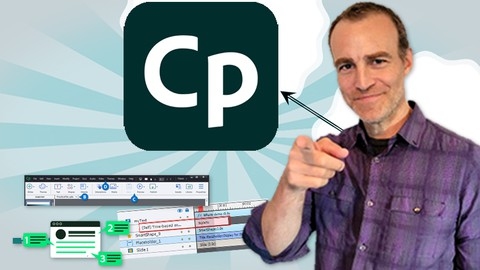Adobe Captivate is a powerful authoring tool that allows you to create interactive eLearning content, software demonstrations, and simulations.
By mastering Adobe Captivate, you can design engaging and effective training materials, interactive simulations, and educational resources.
Whether you’re a corporate trainer, an educator, or an instructional designer, Adobe Captivate empowers you to deliver dynamic and impactful learning experiences.
Finding a high-quality Adobe Captivate course on Udemy that suits your needs can be challenging.
With numerous options available, it’s easy to feel overwhelmed and unsure which course will truly equip you with the skills you need.
You want a course that combines comprehensive instruction with practical exercises, taught by an experienced instructor who can guide you through the intricacies of the software.
Based on our research and analysis, we’ve found that Adobe Captivate Fundamentals 2019 is the best overall Adobe Captivate course on Udemy.
This course provides a solid foundation in using Captivate, covering everything from basic navigation to creating interactive elements and publishing your projects.
But that’s not all!
Udemy offers a variety of other excellent Adobe Captivate courses tailored to different learning levels and specific goals.
Keep reading to discover our recommendations for beginners, advanced users, and those seeking specialized training in areas like simulations and demonstrations.
Adobe Captivate Fundamentals 2019
This Adobe Captivate Fundamentals 2019 course equips you with the skills to design interactive eLearning courses.
You will start by mastering the interface, creating diverse projects, and building fundamental page layouts.
You will learn to integrate text, shapes, images, and modify default objects and the skin editor for a polished look.
You will then explore external media integration, working with images, audio, and video.
You will discover the Captivate Asset Library and learn to design Captivate characters for engaging content.
The course guides you through crafting responsive designs, ensuring your courses adapt seamlessly to different screen sizes.
The curriculum emphasizes interactivity.
You will learn to create both basic and advanced interactions, including working with variables, conditions, and loops.
You will master building engaging quizzes with multiple-choice, true/false, fill-in-the-blank, and more.
You will discover how to add actions, page navigation, and even execute Javascript, adding a new layer of complexity to your designs.
The course also covers animation techniques, enabling you to add transitions, motion paths, and bring your content to life.
Finally, you will learn to publish your course to various platforms, including Learning Management Systems (LMS), and explore different Captivate project types like interactive videos and VR.
Adobe Captivate - Focus on Simulations
You start this Adobe Captivate course by getting a sneak peek at a finished simulation, showing you what you can achieve.
The course then guides you through the essential first steps, including setting up your recording environment and learning how to start Adobe Captivate correctly.
You’ll grasp the importance of planning your simulations effectively because, as the course emphasizes, “Fail to plan - Plan to Fail.”
You then dive into the recording process itself, learning how to record, preview, analyze, and save your first simulation.
You discover how to configure the recording environment and explore various recording settings to gain control over your simulations.
You will discover how to use interactive elements like click boxes and text entry boxes to make your simulations engaging.
You learn to adjust the timing of elements within your simulation, ensuring a smooth and natural user experience.
Once you have your simulation ready, the course shows you how to publish it in various formats, including SWF, HTML 5, EXE, and MP4.
This provides you with the flexibility to share your creations with diverse audiences.
You also learn how to configure playback controls, giving you even more control over how your audience experiences your finished simulations.
Adobe Captivate - Focus on Demonstrations
This Adobe Captivate course teaches you how to create software demonstrations.
You begin by watching a completed demonstration to see what you will learn to create.
You then prepare your computer for recording by configuring recording settings and optimizing your environment.
The course guides you through recording your first demonstration, analyzing the result, and improving the recording.
You discover how to use highlight boxes, text captions, and mouse movements to enhance your demonstrations.
You also learn to adjust the timing of these elements to create a polished final product.
Mastering these tools allows you to effectively emphasize key areas and guide viewers through complex processes.
You finish the course by learning to publish your demonstrations in different formats.
You discover how to export your work as SWF, HTML5, EXE, and MP4 files.
You also learn to configure playback controls to customize the viewer experience.
This ensures you can share your demonstrations on a variety of platforms and tailor them to your audience.
Captivate MASTER CLASS - All Levels - 12 HOURS of content
This Adobe Captivate course begins with the fundamentals of e-learning, ensuring you understand how to make engaging content.
You quickly move into Captivate itself, familiarizing yourself with the interface, workspaces, and tools like fluid boxes for responsive design.
You then explore a wide range of features, from master slides and placeholders to the intricacies of text formatting, image enhancement, and using the asset library.
The course then guides you through creating interactive elements, teaching you how to design buttons, add hyperlinks, and use the timeline.
You delve into more advanced features such as screen recording, creating software demos, and building interactive quizzes with various question types and drag-and-drop activities.
You even explore interactive video and VR, adding another layer of engagement to your projects.
The course emphasizes accessibility.
You learn how to add features like alt text tags for images, closed captions, and proper tab order, ensuring your content is usable by everyone.
You also dive into advanced concepts like branching, which allows you to personalize learning paths, and learn to use variables for tasks such as creating certificates.
The course concludes by teaching you how to add the finishing touches to your projects, guiding you through creating custom skins and tables of contents before showing you how to publish your completed e-learning modules.
Adobe Captivate 6 and 7 Training for Beginners
This Adobe Captivate 6 and 7 course is designed for beginners who want to learn how to create interactive eLearning content.
You’ll begin by exploring the Captivate workspace, where you’ll learn to create new projects, customize the interface, and master adding essential elements like slides, text, and images.
The course then guides you through using ready-made graphic designs called themes, which help you quickly style your eLearning projects.
You’ll discover how to leverage the power of Adobe Creative Cloud applications such as Photoshop, Illustrator, Fireworks, and Flash to produce high-quality visuals.
The course doesn’t just stop at design; you’ll also learn how to import these assets into Captivate and manage them efficiently using libraries.
You’ll delve into the intricacies of slide types, master slides, and the all-important Captivate timeline, gaining a thorough understanding of how to structure and control the flow of your eLearning content.
The course then takes you deeper into creating interactive experiences.
You’ll learn to use buttons, click boxes, and even Smart Learning Interactions in Captivate 7, allowing you to design engaging and dynamic content.
Additionally, you’ll learn to incorporate audio and video elements, create quizzes and assessments, and finally, publish your projects in industry-standard formats like SWF and SCORM.
You’ll even get to test your creations on Scorm Cloud, a free online platform.
Captivate 5 Introduction
You’ll begin by navigating the software, creating projects, and adding text captions.
You quickly learn to work with the timeline and preview your creations, gaining confidence with each step.
The course then introduces software simulations.
You discover how to record your screen, choose the right resolution, and master different recording modes.
This means you can demonstrate complex software processes with ease.
You also learn to enhance your projects by adding new slides, incorporating animations, and using highlight and zoom boxes to focus attention.
Finally, you explore the world of quizzes.
You add question slides, adjust their settings, and even customize the overall quiz experience.
You leave the course understanding how to publish your finished projects, including resizing them, using the skin editor, and exporting to different formats, including Flash.
Master Adobe Captivate: Create Stunning eLearning Content
This Adobe Captivate course takes you from newbie to expert, starting with the fundamentals of building responsive projects that look great on any device.
You will discover how to use fluid boxes, themes, and colors to give your projects a polished feel.
You’ll become comfortable adding and adjusting images and mastering the Master Slide for a consistent look across your eLearning content.
Next, you’ll dive into the exciting world of animation.
You’ll learn how to add characters, buttons, and hyperlinks, breathing life into your eLearning content.
By mastering states and advanced actions, you’ll take control of your content flow, creating engaging and dynamic courses.
In Module 3, you’ll explore the world of multimedia, learning how to add audio effects, video files, and even audio narration.
You’ll also learn to add closed captions, making your content accessible to a wider audience.
Module 4 takes a practical turn, teaching you how to create engaging quizzes.
You’ll discover how to set quiz preferences and create various question types, including multiple-choice, true or false, and fill-in-the-blank.
You’ll also learn to implement quiz remediation, providing valuable feedback to learners.
Finally, you’ll learn how to publish your masterpiece.
The course walks you through the publishing settings, ensuring your eLearning content is ready for sharing across different platforms and devices.
Game like simulations with Captivate 9
This course guides you through the process of creating game-like simulations using Adobe Captivate 9.
You start with the basics of storyboarding to plan your interactive experience.
The course then introduces you to Adobe Illustrator and its fundamental tools and techniques for creating compelling visuals.
You learn to craft engaging animations using Captivate’s master slides, ensuring a consistent look throughout your simulation.
You then dive into building interactive elements.
You learn to create dynamic responses based on user input, a key element of game-like simulations.
The course teaches you how to animate objects, add interactive buttons with effects, and build a stage-select system, allowing users to choose their path.
You also learn to incorporate a scoring system to track user progress.
The course then guides you through setting up different rooms or stages in your simulation.
You discover how to control the user experience by enabling and disabling specific rooms or items within those rooms as users progress.
You learn to design a results slide that displays user performance.
You will even build a health test simulation, setting up a scoring system and allowing users to select avatars and retake the test as needed.








